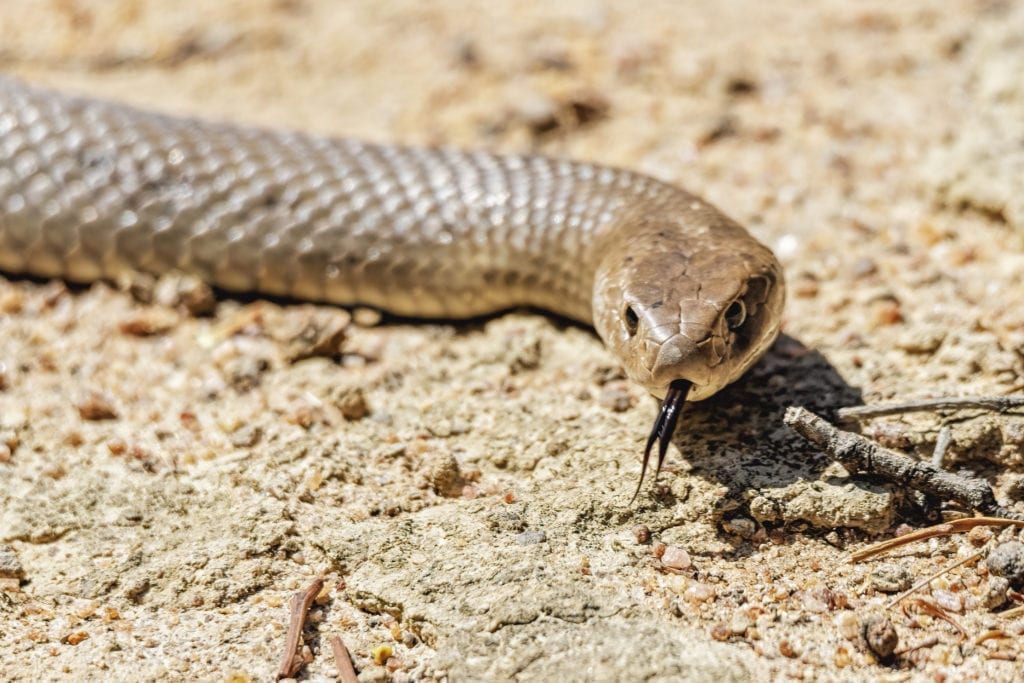Most Aussies know what to do for a snake bite on humans: call 000 immediately for an ambulance, wrap the whole limb with a pressure immobilisation bandage (not too tight) and keep the bite victim calm and still to keep their heart rate down.
But for a snake bite on a dog, it tends to be much more difficult. For a start, they have plenty of fur, which can make it difficult – even impossible – to identify the actual site of the bite.
Dogs are more likely to be bitten on the face or body than the limbs. That’s because of their different size and shape to us humans, and the fact that they may have tried to attack or sniff the snake. It means compression bandaging may not be an option.
Snake bite on a dog: A very personal experience
A number of years ago, I had a first-hand encounter when my dog Shelton (pictured below) – a then four-year-old black Labrador – was bitten by a brown snake.
It was a long weekend, and a group of us were on the family farm in rural NSW.
Shelton was running along the driveway in front of us in the ute, when something darted out from the grass and briefly got tangled between his legs, before being flicked behind him and under the ute.

It happened so unbelievably fast – just a flash – that we didn’t really know what it was. Pondering that it may have been a large stick that we didn’t want in the way, we stopped the car and looked around to try and find it. Instead, we found a large Eastern brown snake that had slithered off the driveway to hide beside a large rock.
I picked up Shelton and we raced back to the house to call the vet. Laying him on the cool floor and trying to keep him calm and still (as much as you can keep a young Labrador still!), I checked him over for any puncture wounds. (See also our article on 7 warning sings of an unhealthy dog to look out for.)
None were visible, and there was no sign of any blood. But the vet suggested we bring him in ASAP regardless.
Emotional and expensive dilemma
We managed to get him to the vet clinic within around 15 minutes. The vet carefully checked him over, just as I had. Again, she couldn’t find any visible puncture marks.
She advised us we had two options: keep him under her close observation for a while to see if he developed any symptoms, or administer the anti-venom as a precaution. The latter would include an overnight stay for close observation, at a cost of around $1,000 (bearing in mind this was 2010, so those treatment costs are almost certainly much higher now).
But the risk of waiting was that, should he develop symptoms, it may then be too late to save him.
It was a lot of money, and I didn’t like the idea of subjecting him to treatments he may not need. But really, there was no choice – my best mate’s life was at stake. And so the vet began preparing the anti-venom.
Just as she began administering the drip, Shelton’s breathing became more laboured. His eyes began to glaze over. He started frothing at the mouth. His heart rate began to change. He had indeed been bitten.
Thankfully, because we actually saw the attack happen and got him treated quickly, Shelton made a full and almost immediate recovery. He was more upset that we left him at the vet overnight than anything else!
We were also lucky, the vet suggested, that he may have only suffered a graze rather than a full bite – and with it a full dose of venom. But on the flip side, given that it was the beginning of snake season, when the reptiles are emerging from hibernation, their venom tends to be at its most potent.
Others not so lucky
Afterwards, with Shelton back to his normal happy self, the vet acknowledged that not everyone is so lucky in saving their dogs from a snake bite.
She recalled another after-hours call about a snake bite on a dog. Only that person didn’t have access to a car at the time, and so the vet had to go to them.
The vet drove out, picked up the dog that had been bitten, and took it back to the clinic for treatment.
But as she was preparing the antivenom, the dog’s owner called again: their other dog had been bitten. With precious minutes running out, and no other vets available at the time, the owner was forced into a truly heartbreaking situation: having to choose which dog to save – the one already being prepped for treatment, or the one in their arms.
My first-hand advice for dealing with a dog snake bite
I’m not a vet, so I obviously can’t give medical advice. But from my own experience with Shelton, if you suspect you’re dealing with a snake bite on a dog, there are a few things I can recommend to boost the chances of your dog surviving this unlucky situation:

- DO keep your local emergency vet’s number on hand – even stored in your mobile. You’ll save valuable minutes not having to search for the number.
- DO ring the vet to let them know you’re coming. This will allow them to prepare for your arrival while you’re in transit. That way, they can begin treating your dog as soon as you get there.
- DON’T approach or go looking for the snake. You could get bitten yourself. Plus, you’ll waste valuable time getting your dog life-saving treatment. Call your local snake catcher or WIRES Wildlife Rescue instead.
- If you have more than one dog, DON’T leave your other pups alone in the yard with the snake. Lock them inside the house or take them with you.
- DON’T wait to act. Every minute can be the difference between life and death, so get your dog to the vet ASAP. (And do so safely: you won’t help your dog by having an accident on the way to the vet.)
- Not finding bite marks is no guarantee that your dog has escaped a snake bite. Bite marks can be hidden by fur or in a hard-to-see place, such as on their tongue, in their ear or between their toes. It’s better to err on the side of caution.
- Don’t go to the vet alone if you can avoid it. It may take several people to keep your dog as still and calm as possible on the way to the vet. Plus, it is a REALLY emotional experience, and both you and your dog will need loads of support!











